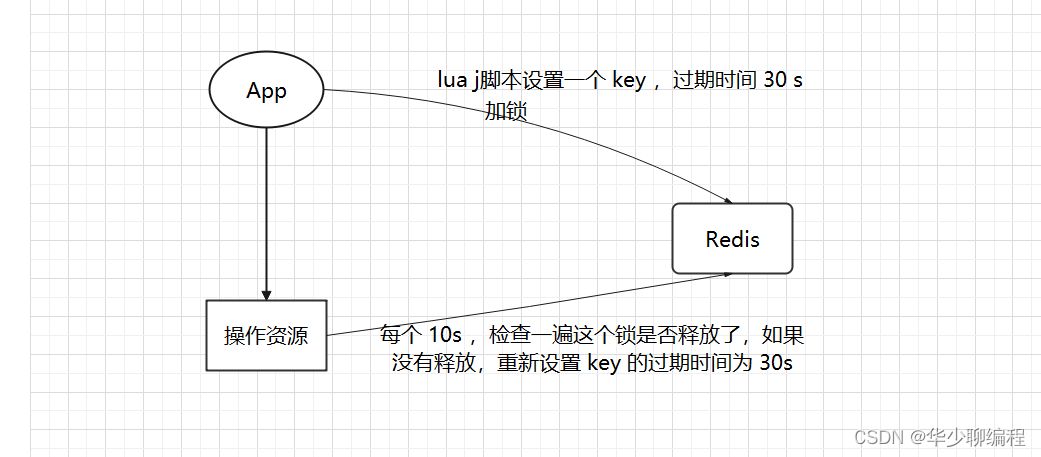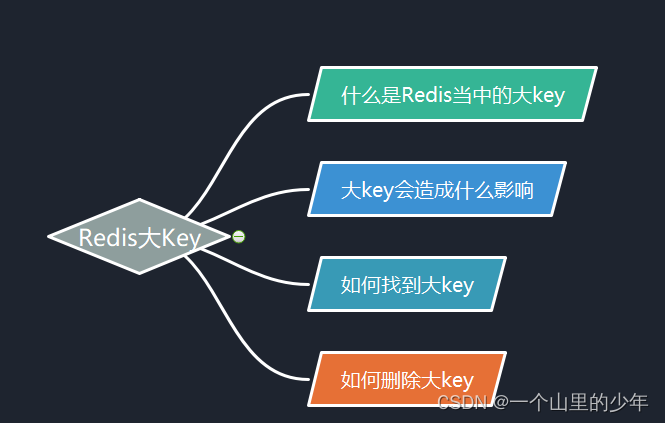假设我们给锁设置的过期时间太短,业务还没执行完成,锁就过期了,这块应该如何处理呢?是否可以给分布式锁续期?
解决方案:先设置一个过期时间,然后我们开启一个守护线程,定时去检测这个锁的失效时间,如果锁快要过期了,操作共享资源还未完成,那么就自动对锁进行续期,重新设置过期时间。
幸运的是有一个库把这些工作都帮我们封装好了,那就是 Redisson,Redisson 是 java 语言实现的 Redis SDK 客户端,它能给 Redis 分布式锁实现过期时间自动续期。
当然,Redisson 不只是会做这个,除此之外,还封装了很多易用的功能:
- 可重入锁
- 乐观锁
- 公平锁
- 读写锁
- Redlock
这里我们只讲怎么实现续期,有需要的小伙伴可以自己去了解其他的功能哦。
在使用分布式锁时,Redisson 采用了自动续期的方案来避免锁过期,这个守护线程我们一般也把它叫做 “看门狗(watch dog)” 线程。
watch dog自动延期机制
只要客户端一旦加锁成功,就会启动一个 watch dog 看门狗。watch dog 是一个后台线程,会每隔 10 秒检查一下,如果客户端还持有锁 key,那么就会不断的延长锁 key 的生存时间。
如果负责存储这个分布式锁的 Redission 节点宕机后,而且这个锁正好处于锁住的状态时,这个锁会出现锁死的状态,为了避免这种情况的发生,Redisson 提供了一个监控锁的看门狗,它的作用是在 Redisson 实例被关闭前,不断的延长锁的有效期。默认情况下,看门狗的续期时间是 30 秒,也可以通过修改 Config.lockWatchdogTimeout 来指定。

另外 Redisson 还提供了可以指定 leaseTime 参数的加锁方法来指定加锁的时间。超过这个时间后锁便自动解开了,不会延长锁的有效期。
接下来我们从源码看一下是怎么实现的。
源码分析
首先我们先写一个 dome 一步步点击进去看。
|
1 2 3 4 5 6 7 |
Config config = new Config(); config.useSingleServer().setAddress("redis://127.0.0.1:6379");
RedissonClient redisson = Redisson.create(config); RLock lock = redisson.getLock("MyLock");
lock.lock(); |
RLock lock = redisson.getLock(“MyLock”); 这句代码就是为了获取锁的实例,然后我们可以看到它返回的是一个 RedissonLock 对象
|
1 2 3 4 5 |
//name:锁的名称 public RLock getLock(String name) { //默认创建的同步执行器, (存在异步执行器, 因为锁的获取和释放是有强一致性要求, 默认同步) return new RedissonLock(this.connectionManager.getCommandExecutor(), name); } |
点击 RedissonLock 进去,发现这是一个 RedissonLock 构造方法,主要初始化一些属性。
|
1 2 3 4 5 6 7 8 9 10 11 12 13 |
public RedissonLock(CommandAsyncExecutor commandExecutor, String name) { super(commandExecutor, name); this.commandExecutor = commandExecutor;
//唯一ID this.id = commandExecutor.getConnectionManager().getId(); //等待获取锁时间 this.internalLockLeaseTime = commandExecutor.getConnectionManager().getCfg().getLockWatchdogTimeout(); //ID + 锁名称 this.entryName = this.id + ":" + name; //发布订阅 this.pubSub = commandExecutor.getConnectionManager().getSubscribeService().getLockPubSub(); } |
我们点击 getLockWatchdogTimeout() 进去看一下:
|
1 2 3 4 5 6 7 8 9 10 |
public class Config {
private long lockWatchdogTimeout = 30 * 1000;
public long getLockWatchdogTimeout() { return lockWatchdogTimeout; }
//省略 } |
从 internalLockLeaseTime 这个单词也可以看出,这个加的分布式锁的超时时间默认是 30 秒,现在我们知道默认是 30 秒,那么这个看门狗多久时间来延长一次有效期呢?我们接着往下看。
这里我们选择 lock.lock(); 点击进去看:
|
1 2 3 4 5 6 7 |
public void lock() { try { this.lock(-1L, (TimeUnit)null, false); } catch (InterruptedException var2) { throw new IllegalStateException(); } } |
|
1 2 3 4 5 6 7 8 9 10 |
private void lock(long leaseTime, TimeUnit unit, boolean interruptibly) throws InterruptedException { long threadId = Thread.currentThread().getId(); Long ttl = this.tryAcquire(leaseTime, unit, threadId); if (ttl != null) { RFuture<RedissonLockEntry> future = this.subscribe(threadId); if (interruptibly) { this.commandExecutor.syncSubscriptionInterrupted(future); } else { this.commandExecutor.syncSubscription(future); } |
上面参数的含义:
leaseTime: 加锁到期时间, -1 使用默认值 30 秒
unit: 时间单位, 毫秒、秒、分钟、小时…
interruptibly: 是否可被中断标示
而 this.tryAcquire()这个方法中是用来执行加锁, 继续跳进去看:
|
1 2 3 4 5 6 7 8 9 10 11 12 13 14 15 16 17 18 19 20 21 22 23 |
private <T> RFuture<Long> tryAcquireAsync(long leaseTime, TimeUnit unit, long threadId) { //执行 tryLock(...) 才会进入 if (leaseTime != -1L) { //进行异步获取锁 return this.tryLockInnerAsync(leaseTime, unit, threadId, RedisCommands.EVAL_LONG); } else { //尝试异步获取锁, 获取锁成功返回空, 否则返回锁剩余过期时间 RFuture<Long> ttlRemainingFuture = this.tryLockInnerAsync(this.commandExecutor.getConnectionManager().getCfg().getLockWatchdogTimeout(), TimeUnit.MILLISECONDS, threadId, RedisCommands.EVAL_LONG);
//ttlRemainingFuture 执行完成后触发此操作 ttlRemainingFuture.onComplete((ttlRemaining, e) -> { if (e == null) { //ttlRemaining == null 代表获取了锁 //获取到锁后执行续时操作 if (ttlRemaining == null) { this.scheduleExpirationRenewal(threadId); }
} }); return ttlRemainingFuture; } } |
我们继续选择 scheduleExpirationRenewal() 跳进去看:
|
1 2 3 4 5 6 7 8 9 10 11 |
private void scheduleExpirationRenewal(long threadId) { RedissonLock.ExpirationEntry entry = new RedissonLock.ExpirationEntry(); RedissonLock.ExpirationEntry oldEntry = (RedissonLock.ExpirationEntry)EXPIRATION_RENEWAL_MAP.putIfAbsent(this.getEntryName(), entry); if (oldEntry != null) { oldEntry.addThreadId(threadId); } else { entry.addThreadId(threadId); this.renewExpiration(); }
} |
接着进去 renewExpiration() 方法看:
该方法就是开启定时任务,也就是 watch dog 去进行锁续期。
|
1 2 3 4 5 6 7 8 9 10 11 12 13 14 15 16 17 18 19 20 21 22 23 24 25 26 27 28 29 30 31 32 33 34 35 36 37 38 |
private void renewExpiration() { //从容器中去获取要被续期的锁 RedissonLock.ExpirationEntry ee = (RedissonLock.ExpirationEntry)EXPIRATION_RENEWAL_MAP.get(this.getEntryName()); //容器中没有要续期的锁,直接返回null if (ee != null) { //创建定时任务 //并且执行的时间为 30000/3 毫秒,也就是 10 秒后 Timeout task = this.commandExecutor.getConnectionManager().newTimeout(new TimerTask() { public void run(Timeout timeout) throws Exception { //从容器中取出线程 RedissonLock.ExpirationEntry ent = (RedissonLock.ExpirationEntry)RedissonLock.EXPIRATION_RENEWAL_MAP.get(RedissonLock.this.getEntryName()); if (ent != null) {
Long threadId = ent.getFirstThreadId(); if (threadId != null) { //Redis进行锁续期 //这个方法的作用其实底层也是去执行LUA脚本 RFuture<Boolean> future = RedissonLock.this.renewExpirationAsync(threadId); //同理去处理Redis续命结果 future.onComplete((res, e) -> { if (e != null) { RedissonLock.log.error("Can't update lock " + RedissonLock.this.getName() + " expiration", e); } else { //如果成功续期,递归继续创建下一个 10S 后的任务 if (res) { //递归继续创建下一个10S后的任务 RedissonLock.this.renewExpiration(); }
} }); } } } }, this.internalLockLeaseTime / 3L, TimeUnit.MILLISECONDS); ee.setTimeout(task); } } |
从这里我们就知道,获取锁成功就会开启一个定时任务,也就是 watchdog 看门狗,定时任务会定期检查去续期renewExpirationAsync(threadId)。
从这里我们明白,该定时调度每次调用的时间差是 internalLockLeaseTime / 3,也就是 10 秒。
总结
面试的时候简单明了的回答这个问题就是:
只要客户端一旦加锁成功,就会启动一个 watch dog 看门狗,他是一个后台线程,会每隔 10 秒检查一下,如果客户端还持有锁 key,那么就会不断的延长锁 key 的过期时间。
默认情况下,加锁的时间是 30 秒,.如果加锁的业务没有执行完,就会进行一次续期,把锁重置成 30 秒,万一业务的机器宕机了,那就续期不了,30 秒之后锁就解开了。


